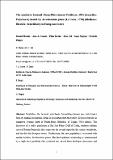Por favor, use este identificador para citar o enlazar a este item:
http://hdl.handle.net/10261/49684COMPARTIR / EXPORTAR:
 SHARE SHARE
 CORE
BASE CORE
BASE
|
|
| Visualizar otros formatos: MARC | Dublin Core | RDF | ORE | MODS | METS | DIDL | DATACITE | |

| Título: | The symbiotic hesionid Parasyllidea humesi Pettibone, 1961 (Annelida: Polychaeta) hosted by Scrobicularia plana (da Costa, 1778) (Mollusca: Bivalvia: Semelidade) in European waters |
Autor: | Martin, Daniel CSIC ORCID CVN ; Cuesta, José A. CSIC ORCID ; Drake, Pilar CSIC ORCID ; Gil, João CSIC ORCID ; Nygren, Arne; Pleijel, Fredrik | Palabras clave: | Hesionodae Symbiosis Bivalvia NE Atlantic Iberian Penninsula |
Fecha de publicación: | 15-may-2012 | Editor: | Springer Nature | Citación: | Organisms Diversity and Evolution 12(2): 145-153 (2012) | Resumen: | Heretofore, the hesionid polychaete Parasyllidea humesi was only known from its original description, living in association with the bivalve Tellina nymphalis in mangrove swamps north of Pointe-Noire (Republic of Congo, West Africa). The discovery of a stable population in Río San Pedro (Gulf of Cádiz, southern Atlantic coast of Iberian Peninsula) thus represents the second report for this species worldwide, and the first for European waters. Furthermore, the new population is associated with another bivalve, Scrobicularia plana. The host-symbiont relationship is characterized by a high host-specificity (the symbiont was absent from Ruditapes decussatus and Cerastoderma glaucum collected in the same habitat and location), regular distribution (one, exceptionally two symbionts per host and then being male and female), and prevalence ranging from 0.22% (in Caño Sancti Petri) to 4.74% (Río San Pedro). The symbionts seem to affect the metabolism of their hosts and, thus, their normal growth, so this association may tentatively be considered as close to parasitism. Parasyllidea humesi seems to be restricted to salt marsh areas with stable marine salinities all over the year. As there is no evidence that the presence of P. humesi in the Gulf of Cádiz results from an introduction, we strongly suggest that it may be better considered as native to the region, with our finding representing the northernmost known geographical limit of its distribution. | Versión del editor: | http://dx.doi.org/10.1007/s13127-012-0086-2 | URI: | http://hdl.handle.net/10261/49684 | DOI: | 10.1007/s13127-012-0086-2 | ISSN: | 1439-6092 | E-ISSN: | 1618-1077 |
| Aparece en las colecciones: | (CEAB) Artículos (ICMAN) Artículos |
Ficheros en este ítem:
| Fichero | Descripción | Tamaño | Formato | |
|---|---|---|---|---|
| Versió d'autor P Humesi.pdf | 465,01 kB | Adobe PDF |  Visualizar/Abrir |
CORE Recommender
SCOPUSTM
Citations
12
checked on 10-abr-2024
WEB OF SCIENCETM
Citations
11
checked on 28-feb-2024
Page view(s)
359
checked on 19-abr-2024
Download(s)
342
checked on 19-abr-2024
Google ScholarTM
Check
Altmetric
Altmetric
NOTA: Los ítems de Digital.CSIC están protegidos por copyright, con todos los derechos reservados, a menos que se indique lo contrario.
